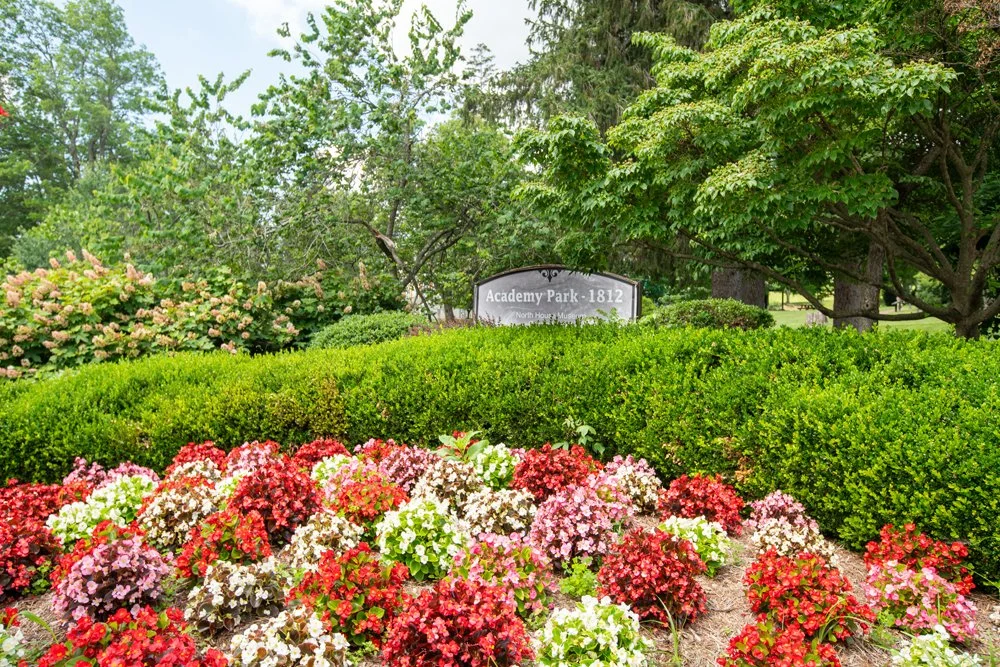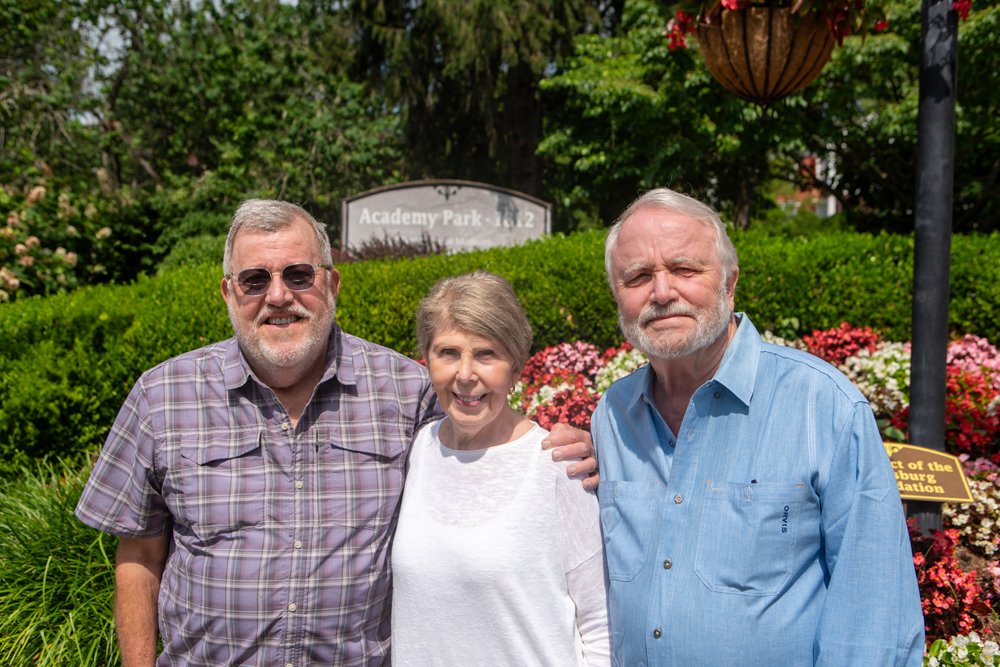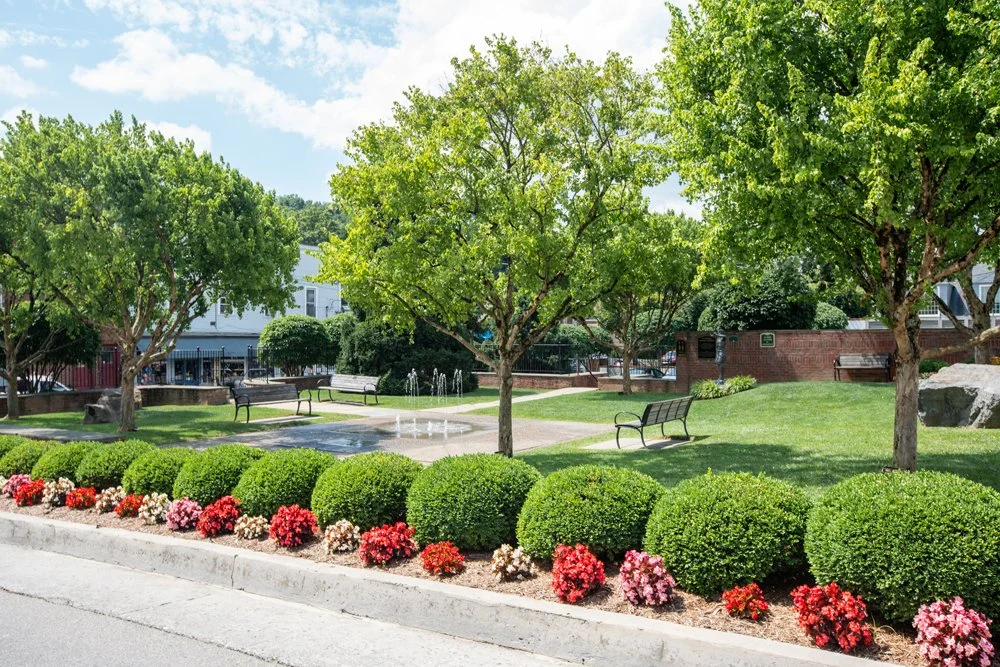Beyond the Blooms: How The Lewisburg Foundation Shaped the Charm of Downtown

By Stephen Kowalkowski | Photos by Josh Baldwin
At the beginning of the 1980s the town of Lewisburg, West Virginia was a bustling county seat featuring a healthy variety of businesses, though not exactly a picturesque tourist attraction. Power lines and telephone wires ran through the heart of downtown. Shoppers could fill their gas tanks but had a hard time finding a meal. Parking was limited, and little attention was paid to how each property contributed to the overall feel of the place. Compared to what it would become, the town was practical but ordinary.
But even this relatively meager state of affairs was threatened by the expansion of Interstate 64, which was sure to bring with it box stores and chain restaurants along its exits. The rise of corporate retail and food at the expense of local downtown areas was a trend playing out across the nation, contributing to the homogenization of American culture and the decay of regional flavor. But while these worrisome trends may have been in the back of the minds of Lewisburg business owners as their immediate crisis loomed, it was their own—and the town’s—survival that inspired the downtown revitalization project that put Lewisburg on the path to becoming what it is today.
Academy Park in Lewisburg
There was no immediate consensus, though, on how best to navigate the inevitable changes that Interstate 64’s completion would bring. One option was to treat the arrival of stores such Walmart and restaurants like McDonald’s as inevitable, a commercial phenomenon not to be fought but accommodated. Old buildings now hosting empty shops could be torn down, and parking lots could take their place.
But the vision that ultimately prevailed was to offer a counterpoint to what these heavyweights would bring. Boutiques, local curiosities, and luxury shops wouldn’t need to compete directly with grocery giants. Succeeding with this approach, though, was not so simple as “build it, and they will come.” Local dollars couldn’t support so many businesses of that kind. No, Lewisburg needed to become a regional draw, the kind of charming destination that would inspire trips across state lines.
Other towns and cities across America were facing the same struggle, and government programs had sprung up in response, offering urban-renewal grants. But citizens couldn’t access these funds as private individuals or even as business owners; they needed to form a non-profit organization to apply for them on their behalf. And that’s how the Lewisburg Foundation came to be.
Since its formation in 1980, the Foundation has pursued projects that protect and enhance the historic values and natural charm of Lewisburg. Some of its first steps were to move power lines and add street trees and street lights. It was instrumental in creating the town’s historical district. And it helped craft the regulations for local facades and signage, striving toward a unified aesthetic for the city.
Josh Polan, Annabelle Galyean, Tag Galyean
But after pursuing these projects for a handful of years, the Foundation had completed its to-do list. The organization remained in existence and even had a little money in the bank, but from 1986 until 1997 it mostly lay dormant. During that time, downtown Lewisburg weathered the arrival of Interstate 64 and its accompanying changes, but thirty percent of stores downtown became vacant. And there was still just a single restaurant.
That’s when architect TAG Galyean and wife Annabelle of the TAG Studio became President and Treasurer of the Lewisburg Foundation. And Brandon Johnson, Roger Holiday, and Lynn Brody eagerly joined the Board of Directors. TAG then approached friend and landscape architect Josh Polan. TAG and Polan grew up half a mile from one another in Charleston in the 1950s. Galyean attended Stanford University before transferring to The Pratt Institute in New York to study architecture. He then worked for himself in New York before returning to West Virginia, eventually making his home in Lewisburg after completing projects for The Greenbrier. Polan studied landscape architecture at Cornell University and in 1976 established Riverbend Nursery in Caldwell. Together, they bring complementary expertises in crafting spaces people want to visit.
In the 27 years they’ve lead the Lewisburg Foundation, the two have sought to identify spaces downtown that could be enhanced or transformed. After first becoming drawn to a space, Polan and Galyean collaborate on a design proposal, which they then shop around to donors. If the design generates enough enthusiasm, grant money and specific gifts from individual memberships, friends of Lewisburg, and private foundations are funneled into what’s known as a Capital Project. Capital costs have included new gardens, street trees, benches, receptacles, and sculpture. Since the organization’s personnel consists of the president, vice president, and treasurer, all of whom donate their time and energy, that money goes directly toward developing the site, which is then maintained through membership fees. The amount each member pays is decided by the individual, but the required maintenance funds total approximately $45,000 per year. They cover mowing, fertilization, watering, pruning, replacing, mulching, weeding, and planting of trees, shrubs, and perennials, as well as planting extensive beds of annual flowers each spring and fall. Through the combination of these Capital Projects and upkeep, the Foundation has created and now maintains gateway park areas, downtown gardens, Washington Street parketts, and historic district signage. And in the interest of community recreation development, the Lewisburg Foundation in recent years collected and processed the donations that designed and built the Hollowell Park Pickleball Courts and the Greenbrier Valley Aquatic Center.
Lewisburg Green Space
A more recent initiative of the Foundation is the Tree Replacement Program. While Lewisburg is graced with an urban forest of large trees, many are elderly and in decline. With a view to the next 100 years, Lewisburg Foundation purchases and plants substantial trees on both public and private property. The program began in October 2022 and will last ten years in total, providing both large shade trees and small decorative trees with a retail value of up to $1000 each. The new trees are a variety of oaks, maples, elms, dogwoods, redbuds, London plane, and Norway spruce. In discussing the tree program, Polan cited shade, aesthetics, and wildlife habitats. He referenced studies testifying to the health benefits of clean air and highlighted the longterm thinking driving this project. “We’re planting for our grandchildren,” he said, contrasting the initiative with work offering more immediate satisfaction, such as hanging flower baskets. The tree program is managed by Ron Curry and Byron Black. Curry is an urban forester who moved here from Denver, and Black is owner of Riverbend Landscaping.
In addition to preserving specific trees, Lewisburg Foundation strives to protect a more nebulous aspect of Lewisburg, its farm-like authentic feel. Twenty-five years ago, after becoming aware that a plot of land along one of the main entrances to town was to trade hands and likely become a filling station, the Foundation approached the sellers through their bank and made an offer they couldn’t refuse, preserving the green plot of land and erecting a flag pole as a more-scenic alternative to that convenience store. This attempt at land conservation felt a bit out of character, but over a hundred donors supported the bold proposal and made the idea a reality. “You don’t miss these things until they’re gone,” Polan said, celebrating these verdant patches of town that can so easily be conceded to commercial interests over time. Galyean and Polan pointed to the Foundation’s long track record and the dedication of treasurer Annabelle Galyean as to how they could so quickly pull together the funding for this idea. “People who’ve seen our work and commitment know that we’re not just calling to chat,” said Polan.
While the Lewisburg Foundation under Galyean and Polan’s tutelage has played an elemental role in the town’s beautification, they’ve been aided by various businesses who have offered their services at a discount out of respect for the organization’s work. The Foundation outsources much of the maintenance, and an important part of the project proposal process entails estimating how much maintenance will be required, knowing that these tasks and their associated costs must continue day after day, year after year. “Visitors might think that the city does all this or that God does it,” Gaylean said, referring to this extensive caretaking. But it’s not a matter of letting the rain fall from the sky. Many of the vibrant colors around town would turn brown if it weren’t for one of the Foundation’s many partners, Frank Scott of Heirloom Landscaping, who waters five to six nights a week between midnight and 5 a.m.
As for receiving credit for these behind-the-scenes efforts, the organization’s name doesn’t help. “Lewisburg Foundation” sounds like an organization that might be giving money instead of receiving it. The name has no connotations of horticulture, doesn’t conjure in the imagination the intricate design plans for the incoming million-dollar parking lot on the west end of town. It’s a hand-me-down name from an earlier era of the organization, before Polan and Galyean took the reins.
But it suits the two men in a way. When discussing the Foundation’s work, they spoke with age and wisdom, having internalized the snowball effects of their vision and efforts. They hold in their memories versions of the town that span decades, a record of change for the better. And having participated in many municipal-level discussions of urban planning, they see how, for example, the Center Green and its centerpiece fountain could have been a parking lot if their arguments hadn’t won out. They notice a merchant hanging baskets of flowers and feel confident their own work played a distantly causal role in the act because it’s easier to make an effort when you see effort is already being made. All throughout Lewisburg, townsfolk and visitors take in the natural beauty but probably pass over the attributed names on accompanying plaques. And in conversation it was only after a bit of prodding before Galyean conceded, in reference to the untold number of donated hours of professional expertise he, Polan, and Annabelle put in over the years, “It was a great gift.”
It was a great gift and continues to be.












